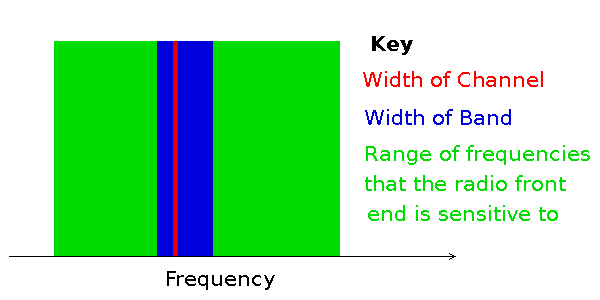Front-End Blocking
If you’re an RF engineer and you haven’t heard of front-end blocking then you’re lucky. I suspect you will hear about it soon, during the last few years I’ve done a lot of work on this problem. The diagram below shows the basic problem. A radio receiver only needs to be sensitive to the band of frequencies that it must receive, there is no need for the radio to have any sensitivity to other frequencies. However, that doesn’t mean that a receiver will reject incoming signals that are out-of-band. Most designs of receiver front-end are sensitive to a much broader range of frequencies than the band in question.
Suppose that a signal is being transmitted in the frequency range marked in green on the picture above. That signal will be captured by the receiver front-end along with the wanted signal. Then the receiver may cause the two signals to interact garbling the information from the wanted signal. There are several different ways that this can happen in different parts of the receiver circuit, I may write about those another day.
In this scenario the interfering signal isn’t in-band, it’s out-of-band, but it still causes a problem. For the sensitive receivers used in modern digital communications systems the power of the interfering signal doesn’t have to be high to cause reduced performance or complete link failure.
There are six general approaches to mitigating this problem:
- Move the receiving antenna away from sources of interference
- Break the path between the source of interference and the receiving antenna
- Make the receiving antenna more narrowband
- Add in a band-limiting filter between the antenna and the receiver
- Make the receiver less sensitive to out-of-band signals
- Change the receiver design so that the wanted signal and out-of-band signals don’t interact or interact less
I’ve used most of these strategies, in the future I’ll write about them in more detail.
Tags: Blocking, Front-Ends, Radios

